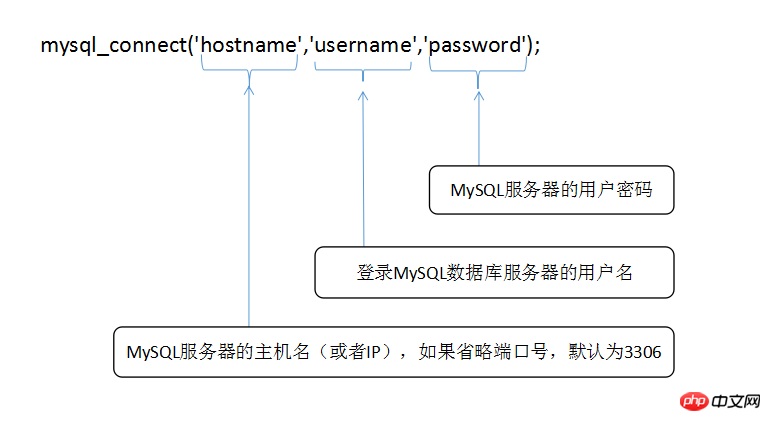 Database
Database
 Mysql Tutorial
Mysql Tutorial
 Use the mysql_connect() function to connect to the database (PHP method 1 for operating MySQL database)
Use the mysql_connect() function to connect to the database (PHP method 1 for operating MySQL database)
Use the mysql_connect() function to connect to the database (PHP method 1 for operating MySQL database)
How to operate MySQL database with PHP - use the mysql_connect() function to connect to mysql
##PHP provides a large number of MySQL database functions to facilitate the operation of the MySQL database Operation makes the development of web programs simpler and more flexible. In the previous article "Detailed explanation of the five steps of PHP accessing the MYSQL database (picture)", the steps for PHP to access the database were introduced. In this article we will introduce PHP to operate the database. Methods!
Use the mysql_connect() function to connect to mysql
To operate the MySQL database, you must first establish a connection with the MySQL server. The syntax format for connecting to the MySQL server As follows:mysql_connect('hostname','username','password');

<?php
header("Content-Type:text/html; charset=utf-8");
$link = mysql_connect("localhost","root","root")or die("不能连接到数据库服务器!".mysql_error()); //连接MySQL 服务器
if($link){
echo "连接数据库成功";
}
?>
Note:
If you close the MySQL server, a prompt message will be output:
Can't connect to MySQL server on "localhost"(10061)
In the above code, use the mysql_connect() function to connect to the MySQL database server. As you can see from this function, you can Specify a non-local machine name as the database server, which ensures the off-site storage of data and the security isolation of the database. External user Wangwang has direct access rights to the WWW server. If the database system is placed directly on the WWW server, it will bring security risks to the MySQL database. If a firewall is installed for the database system, then PHP can access the database through the LAN, and the computers inside the LAN are invisible to the outside. This ensures that the database is not attacked by outsiders. In order to facilitate querying errors that occur due to connection problems, it is best to add an error shielding mechanism performed by the die() function. The above example uses the mysql_error() function to extract the error text of the MySQL function. If there is no error , an empty string is returned. If the browser displays the words "Warning: mysql_connect()...", it means that the database connection is wrong, so that the error location can be quickly discovered and corrected in time.Tips:
#In website development, errors are inevitable. Developers should try their best to avoid errors and make them in a timely manner. It is also necessary to accurately find the cause of the error, which requires constant accumulation of experience!
Mysql_connect() function connects to the database. We will introduce it here. Below we will introduce how to select a database file. For details, please read "PUsing the mysql_select_db() function to select a database file (PHP Method 2 of operating MySQL database)》!
The above is the detailed content of Use the mysql_connect() function to connect to the database (PHP method 1 for operating MySQL database). For more information, please follow other related articles on the PHP Chinese website!

Hot AI Tools

Undresser.AI Undress
AI-powered app for creating realistic nude photos

AI Clothes Remover
Online AI tool for removing clothes from photos.

Undress AI Tool
Undress images for free

Clothoff.io
AI clothes remover

Video Face Swap
Swap faces in any video effortlessly with our completely free AI face swap tool!

Hot Article

Hot Tools

Notepad++7.3.1
Easy-to-use and free code editor

SublimeText3 Chinese version
Chinese version, very easy to use

Zend Studio 13.0.1
Powerful PHP integrated development environment

Dreamweaver CS6
Visual web development tools

SublimeText3 Mac version
God-level code editing software (SublimeText3)

Hot Topics
 1662
1662
 14
14
 1419
1419
 52
52
 1311
1311
 25
25
 1261
1261
 29
29
 1234
1234
 24
24
 MySQL and phpMyAdmin: Core Features and Functions
Apr 22, 2025 am 12:12 AM
MySQL and phpMyAdmin: Core Features and Functions
Apr 22, 2025 am 12:12 AM
MySQL and phpMyAdmin are powerful database management tools. 1) MySQL is used to create databases and tables, and to execute DML and SQL queries. 2) phpMyAdmin provides an intuitive interface for database management, table structure management, data operations and user permission management.
 The Continued Use of PHP: Reasons for Its Endurance
Apr 19, 2025 am 12:23 AM
The Continued Use of PHP: Reasons for Its Endurance
Apr 19, 2025 am 12:23 AM
What’s still popular is the ease of use, flexibility and a strong ecosystem. 1) Ease of use and simple syntax make it the first choice for beginners. 2) Closely integrated with web development, excellent interaction with HTTP requests and database. 3) The huge ecosystem provides a wealth of tools and libraries. 4) Active community and open source nature adapts them to new needs and technology trends.
 MySQL vs. Other Programming Languages: A Comparison
Apr 19, 2025 am 12:22 AM
MySQL vs. Other Programming Languages: A Comparison
Apr 19, 2025 am 12:22 AM
Compared with other programming languages, MySQL is mainly used to store and manage data, while other languages such as Python, Java, and C are used for logical processing and application development. MySQL is known for its high performance, scalability and cross-platform support, suitable for data management needs, while other languages have advantages in their respective fields such as data analytics, enterprise applications, and system programming.
 The Compatibility of IIS and PHP: A Deep Dive
Apr 22, 2025 am 12:01 AM
The Compatibility of IIS and PHP: A Deep Dive
Apr 22, 2025 am 12:01 AM
IIS and PHP are compatible and are implemented through FastCGI. 1.IIS forwards the .php file request to the FastCGI module through the configuration file. 2. The FastCGI module starts the PHP process to process requests to improve performance and stability. 3. In actual applications, you need to pay attention to configuration details, error debugging and performance optimization.
 Explain the purpose of foreign keys in MySQL.
Apr 25, 2025 am 12:17 AM
Explain the purpose of foreign keys in MySQL.
Apr 25, 2025 am 12:17 AM
In MySQL, the function of foreign keys is to establish the relationship between tables and ensure the consistency and integrity of the data. Foreign keys maintain the effectiveness of data through reference integrity checks and cascading operations. Pay attention to performance optimization and avoid common errors when using them.
 How to safely store JavaScript objects containing functions and regular expressions to a database and restore?
Apr 19, 2025 pm 11:09 PM
How to safely store JavaScript objects containing functions and regular expressions to a database and restore?
Apr 19, 2025 pm 11:09 PM
Safely handle functions and regular expressions in JSON In front-end development, JavaScript is often required...
 Compare and contrast MySQL and MariaDB.
Apr 26, 2025 am 12:08 AM
Compare and contrast MySQL and MariaDB.
Apr 26, 2025 am 12:08 AM
The main difference between MySQL and MariaDB is performance, functionality and license: 1. MySQL is developed by Oracle, and MariaDB is its fork. 2. MariaDB may perform better in high load environments. 3.MariaDB provides more storage engines and functions. 4.MySQL adopts a dual license, and MariaDB is completely open source. The existing infrastructure, performance requirements, functional requirements and license costs should be taken into account when choosing.
 SQL vs. MySQL: Clarifying the Relationship Between the Two
Apr 24, 2025 am 12:02 AM
SQL vs. MySQL: Clarifying the Relationship Between the Two
Apr 24, 2025 am 12:02 AM
SQL is a standard language for managing relational databases, while MySQL is a database management system that uses SQL. SQL defines ways to interact with a database, including CRUD operations, while MySQL implements the SQL standard and provides additional features such as stored procedures and triggers.



